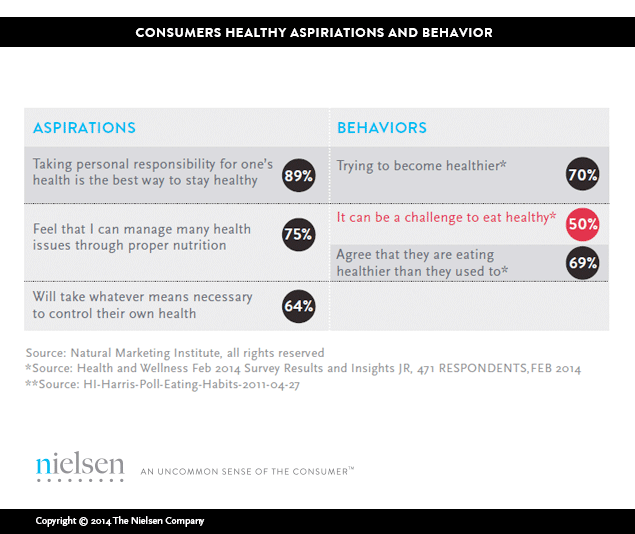Healthy Aspirations: The Disconnect Between Americans’ Desire for a Healthy Lifestyle and Actual Behavior
August 23, 2014
![]() Health and wellness is trending. At the start of year, U.S. consumers listed health among their top five concerns for 2014. Concurrently, the popularity of fitness bands, smartphone apps that track health and fresh food sales have all risen dramatically.
Health and wellness is trending. At the start of year, U.S. consumers listed health among their top five concerns for 2014. Concurrently, the popularity of fitness bands, smartphone apps that track health and fresh food sales have all risen dramatically.
Despite the recent explosion of the health and wellness industry, however, one-third of American adults remain clinically obese.* According to findings in the Nielsen/NMI Health and Wellness in America report, we literally want to have our cake and carrot juice—and eat them, too. For example, while 75 percent of us say we feel we can manage health issues through proper nutrition, a whole 91 percent of us admit to snacking all day on candy, ice cream and chips. So why is there a disconnect between our what we know is healthy and what we actually do? What are the perceptions around “health foods” that prevent us from making better choices? And how can retailers help bridge the gap?
American consumers overwhelmingly aspire to lead healthy lives. For example, 89 percent say taking personal responsibility for one’s health is the best way to stay healthy, 75 percent say they feel they can manage health issues through nutrition, and 64 percent say they will take whatever means necessary to control their own health. However, when it comes down to putting those thoughts into action, only 70 percent say they’re actually “actively trying to be healthier,” 50 percent say it’s a challenge to eat healthy, and 66 percent say they don’t exercise enough.

When it comes to healthy habits, life appears to get in consumers’ way. Along with health, food prices were among consumers’ top five concerns for 2014. More than half of consumers cite “rising food prices” as a barrier to healthy eating§, and 54 percent of consumers agree that “healthy foods are too expensive to eat regularly.”† As a result, shoppers aren’t buying healthier options even when they’re available. In a Nielsen Global Survey, half of U.S. consumers said the availability of organic or nutritionally-enhanced products at grocery had no or next-to-no impact on their grocery purchases in the last year.
Beyond the practicalities of price, however, taste also influences consumers’ food shopping decisions. Half of consumers agreed that “…healthy food should taste good, and I am not willing to give up taste for health.” Given concerns with price and taste, it shouldn’t come as a big surprise that when consumers are spending more—such as when dining out—their healthy habits are kicked to the curb. More than 50 percent of consumers say they “splurge” when dining out and give in to cravings.
Of course, another reason for this gap could be the broad nature of health and wellness. Consumers today face a wide range of concerns, problems and diseases—and not every person focuses on every issue. To help consumers balance their desires for healthier lives with their not-so-healthy lifestyles, retailers should consider introducing solutions designed to address specific conditions.
For example, two areas that all ages, but especially Baby Boomers and Matures, cite as the most important wellness aspirations are weight maintenance and heart health. These health-aware population segments recognize that achieving these goals requires taking personal responsibility for managing health through proper nutrition. This finding suggests that advertising and promotional campaigns emphasizing the personal responsibility angle of health and wellness could be highly effective with these groups, especially as satisfaction with America’s healthcare system continues to wane.
The message is clear—Americans are well intentioned when it comes to their health and wellness goals, but their aspirations are not yet reality. We want to be healthier, to eat better, to exercise, we know what we need to do to lead healthier lives, yet our busy lifestyles get in the way. We are looking for solutions, and manufacturers and retailers face a real opportunity to help bridge the gap. By understanding the need of consumers and the obstacles getting in the way of their healthy aspirations, the industry can solve for consumers’ needs and have a positive effect on their health and wellness.
*“Adult Obesity Facts,” Fact Sheet, Centers for Disease Control and Prevention, March 28, 2014.
§Nielsen Global Online Survey—Q1 2012 †Natural Marketing Institute 2013 Health & Wellness Trends Database
































